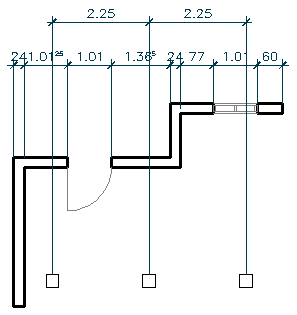In an AEC dimension style, you can define points on objects that are dimensioned associatively with this AEC dimension style. The points that are available for each object are dependent on the object features. For example, in a wall you can dimension length, width, wall components, and openings in the wall. In a window, you can dimension the maximum and minimum opening widths, and the window center.
Each AEC dimension can have up to ten dimension chains. Each chain can contain dimension points for the objects specified in the style.
Example 1: You create an AEC dimension style that contains only one chain. This chain contains wall lengths and wall intersections and the maximum opening width of openings within the wall.

Single AEC dimension chain example
Example 2: You create an AEC dimension style designed exclusively to dimension walls, but the wall dimension points are distributed on four individual chains:
- Chain 1 dimensions the wall lengths and the wall widths.
- Chain 2 dimensions the wall lengths, wall widths and wall intersections.
- Chain 3 dimensions only the wall lengths.
- Chain 4 dimensions the outer boundaries of all selected walls.

Four AEC dimension chains example
Example 3: You create an AEC dimension style that dimensions the length of walls in a building on one chain, and a row of structural columns within the building on a second chain.

Two AEC dimension chains example
The following guidelines can help you to create AEC dimension styles:
- Create a separate dimension style for each use. For example, create a style that dimensions window assemblies and curtain walls, and another one that dimensions walls and openings in walls.
- Do not include too many dimension points in one dimension chain.
- Do not include too many objects within one dimension style.